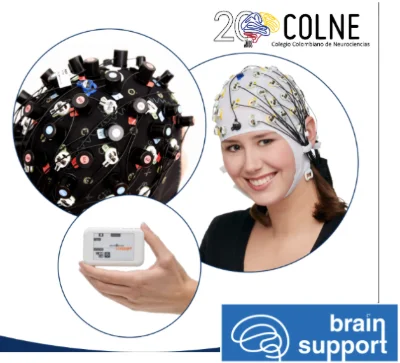COLNE Emotions and the Cortical Spreading Depression (CSD) Mechanism
COLNE 2025 - National Congress of Neurosciences
National Congress of Neurosciences in ColombiaConsciousness, Belonging, and Disease: An Integrated Perspective from Colombian Neuroscience

COLNE 2025 - National Congress of Neurosciences
Human consciousness – that complex phenomenon allowing us to perceive ourselves and the world – can be understood as a self-perceptive movement of metabolism. This perspective, integrating biology, cognition, and society, resonates strongly with themes from the Colombian Congress of Neuroscience (COLNE), where researchers explore everything from molecular processes to structural inequalities.
COLNE Emotions and the Cortical Spreading Depression (CSD) Mechanism

NIRS EEG COLNE
CSD and Emotion Regulation
- CSD is a wave of neuronal activity that spreads across the brain, modulating cortical excitation or inhibition.
- Emotions act as "gradients" of this wave, adjusting brain activity focus and intensity:
- Increased energy (e.g., joy, curiosity) → heightened activation in specific regions.
- Reduced energy (e.g., sadness, exhaustion) → protective suppression to prevent overload.
Monitoring Techniques (fNIRS + EEG)
- fNIRS: Measures hemodynamic changes (cerebral oxygenation – HbO/HbR), revealing metabolic patterns linked to emotions.
- EEG-DC: Correlates slow electrical shifts (CSD) with hemodynamic responses.
- EEG Microstates: Complements fNIRS by capturing fast electrical activity.
Emotions as Metabolic and Connectomic Phenomena
- Alter oxygen consumption and cortical blood flow.
- Reorganize the brain connectome (e.g., persistent frustration).
- Consolidate episodic memories (e.g., prefrontal cortex).
CSD Monitoring Regions:
- Somatosensory cortex (C3, C4, CP5, CP6).
- Visual cortex (O1, O2, PO7, PO8).
- Frontal cortex (Fp1, Fp2, AF3, AF4).
- Parietal cortex (P3, P4, P5, P6).
fNIRS + EEG are powerful tools for studying cortical dynamics in acute and chronic emotional states, though they cannot access subcortical structures (e.g., amygdala).
- Integrating these techniques opens new avenues for research of psychiatric disorders.
Keywords: CSD, fNIRS, EEG-DC, connectome, cortical metabolism, biomarkers.
The Thinking Metabolism: Biological Foundations of Consciousness
When we say consciousness is metabolic movement*, we refer to the energetic processes underlying brain activity – a central theme in COLNE presentations like "Brain lipid metabolism in Alzheimer's" and *"Brain Health". The production of ATP in neuronal mitochondria, neurotransmitter signaling, and even quantum fluctuations in microtubules (as proposed by Hameroff and Penrose) form the foundation of this "metabolic self." Diseases like Alzheimer's, discussed in "CSPa: a molecular link between rare and common dementias", emerge when this equilibrium breaks down, freezing the plasticity of connectomes (neural networks we classify as Paper, Stone, and Scissors).
Belonging: When Cells Whisper Collectively
But how does this individual metabolism connect to the social sphere? We propose that Human Quorum Sensing (HQS) – inspired by bacterial mechanisms – regulates belonging through biochemical signals. Inflammatory cytokines, microbiome-derived butyrate, and even pheromones act as "group messengers," influencing behavior before conscious awareness. This invisible dialogue explains:
- Why autism animal models (like those in "The autism-associated loss of delta-catenin") show social interaction deficits: their cells fail to "tune in" to HQS.
- How structural inequality (addressed in "Impact of inequality on brain aging") alters neural patterns, making brains more rigid and less adaptable.
Connectomes in Action: Paper, Stone, and Scissors
If metabolism is the musical score, connectomes are the performed symphony. At COLNE, sessions like "Neurobiology of Learning" and "Temporal adaptation of visual neurons" explore how neural networks adapt to challenges. Our classification offers a unique lens:
- Stone (amygdala, insula): Rapid reactions, as studied in "Multimodal biosignals for impulsivity disorders"
- Scissors (prefrontal cortex): Detailed analysis, affected in Alzheimer's ("Single-cell approaches in Alzheimer's")
- Paper (DMN, hippocampus): Metacognition and memory, linked to "Social Neuroscience" and mental health
Neurotechnologies and Future Directions: Rewriting the Neural Code
Advances presented at COLNE – like AI for studying epilepsy-Alzheimer's links or complex systems models – enable precise interventions:
- Biofeedback to train Stone connectomes (impulse control)
- Diets and probiotics modulating HQS to enhance belonging
Conclusion: A Science Integrating Scales
Colombian neuroscience, as seen at COLNE, already navigates from molecules to society. Our model proposes that consciousness, disease, and social connection are facets of a single dynamic metabolic process.
Next steps? Testing these ideas through interdisciplinary collaborations combining genetics ("Advances in neurogenetics"), epigenetics ("Epigenetic regulation in early stress"), and social justice ("Inequality and neurodegeneration").
For COLNE Implementation: This content could be adapted as:
- A keynote lecture on consciousness and metabolism
- A panel discussion with experts in autism, Alzheimer's, and neurotechnology
- A conference paper linking these themes
COLNE 2025 - National Congress of Neurosciences
COLNE 2025 - Congreso Nacional de Neurociencias
COLNE 2025 - Congresso Nacional de Neurociências

COLNE2025
#COLNE2025
#Innovation
#Decolonial
#Neuroscience
#Consciousness
#DamasianMind
#Metabolism
#Learning
#Connectome
#Emotions
#Alzheimer
#Autism
#Neurotechnology
#Epigenetics
#EEGmicroStates
#EEGDC
#EEGERP
#NIRS
#NIRSfNIRS















